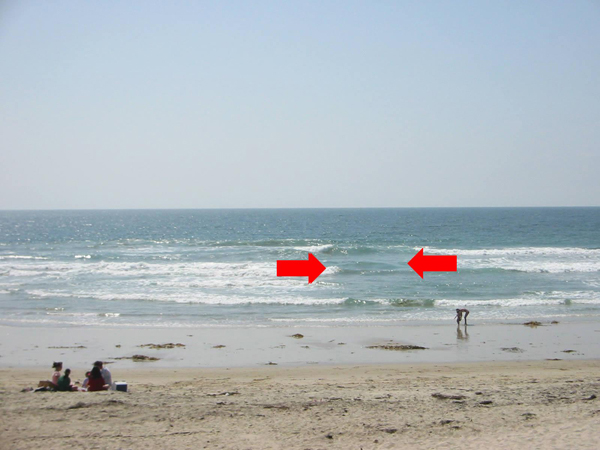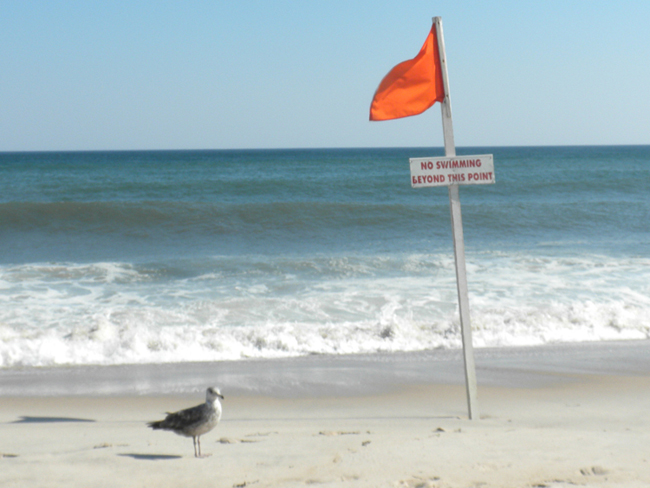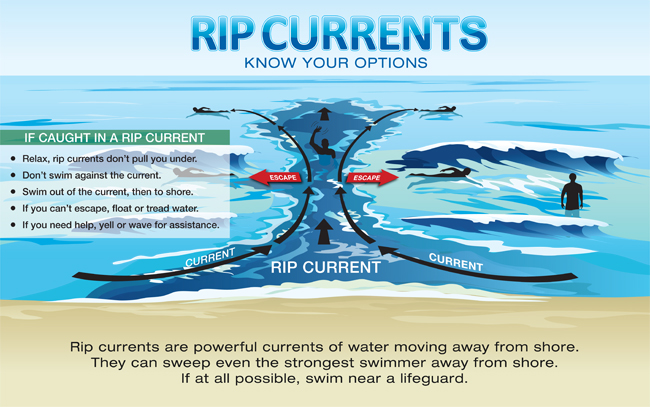
Rip Currents: Break the Grip of the Rip. Credit: Loriann Cody
NOAA National Weather Service Provides Beachgoers with Real-time Surf Zone Forecasts
Early June 2019 Update: Revised content related to NOAA's national rip currents messaging campaign is now featured below.
Contacts:
Kathleen Fallon, Coastal Processes & Hazards Specialist, NYSG, E: kmf228@cornell.edu, P: (631) 632-8730
Stony Brook, NY, June 15, 2018 – Kathleen Fallon, the Coastal Processes & Hazards Specialist for New York Sea Grant (NYSG) is providing resources about rip currents to beachgoers with a new fact sheet. With peak beach season quickly approaching, rip current awareness information is of great interest. Not only does the fact sheet educate beachgoers about rip currents but also instructs them on how to avoid becoming victim to a rip.

As seen in this picture between the red arrows, some rip currents can be identified as an area of calm water in between breaking waves. Although this looks inviting from the beachgoer’s perspective, it could be deadly! Credit: NYSG.
Rip currents, which are narrow channels of fast-moving seawater that pull swimmers away from the shore, kill around 100 beachgoers each year according to the United States Lifesaving Association (USLA). On average, 80% of all lifeguard rescues at surf beaches can be attributed to rip currents. “Educating beachgoers about rip currents and how to spot them before they’re in the proximity of one is essential” said Fallon.
Once a swimmer becomes caught in a rip current, typically, their response is to panic and try to fight against the current in a desperate attempt to reach the shore. This intuitive response is counterproductive and will quickly exhaust a swimmer and increase their risk of drowning due to fatigue, the most common cause of rip-related fatalities. Another problematic intuitive response is the urge to attempt to save swimmers caught in rip currents, witnesses should instead alert a lifeguard or call 911.
Swimmers should remember to remain calm; rip currents are narrow and by swimming parallel to the shoreline, a victim can easily escape the grip and return to the beach safely. If the victim is not a confident swimmer, they can float and tread water, while drawing attention by calling or waving for help.

Please read, obey and know the meaning behind warning flags, as they are there to protect you. Read the safety signs at the entrance to the beach. Once on the sand, look for beach warning flags, often posted on or near a lifeguard’s stand. Warning flags aren’t used in all areas and their meaning can vary from area to area. Credit: NYSG.
Kathleen Fallon is available to serve as an expert resource for rip current information. Fallon has a strong research and academic background in rip current research. At Florida International University, Fallon wrote her PhD. Dissertation on “Rip Current Formation and Beach Safety Implications for Several U.S. Atlantic Coast Beach Areas.”
Looking ahead, Fallon will be working on additional rip currents awareness endeavors with the National Weather Service New York, which recently launched their Web site for surf zone forecasts to improve rip current forecasting and beach safety messaging. More information about rip currents and beach safety can also be found by visiting New York Sea Grant’s Web site, or by contacting New York Sea Grant’s Marine District Extension Office (631) 632-8730.
On YouTube: Break The Grip of the Rip
Part of NOAA Ocean Today's Rip Currents video series
Video Transcript: We all love the beach in the summer. The sun, the sand, and the surf. But just because we're having fun, doesn't mean we can forget about safety.
Rip currents account for 80% of beach rescues, and can be dangerous or deadly if you don't know what to do.
Know before you go. Check local beach forecasts before you head to the beach, and always swim near lifeguards. Look for any warning signs or flags. If you're unsure about conditions, ask a lifeguard. And know how to swim before you venture in.
If you do happen to be caught in a rip current, stay calm. It won't pull you under - it'll just pull you away from shore. If you try to fight the rip current and swim against it, you'll just get worn out. Instead - float!
If you're a good swimmer, swim parallel to shore until you've cleared the pull of the rip current. Swim with the waves, allowing them to push you to shore.
If you can, wave and yell to get the attention of lifeguards and people on shore to let them know you need help.
If you're on shore and see someone in trouble in a rip current call for help! If a lifeguard is not available, throw in something that floats or extend a reaching object, but don't try to be a hero and make the rescue yourself. Even trained lifeguards only attempt a rescue using a flotation device.
Rip currents can be dangerous, but if you know your options, survey your situation, and stay calm, you can stay safe and continue to have fun in the surf, sand, and sun.

Fast Facts
Rip currents are powerful, narrow channels of fast-moving water that are prevalent along the East, Gulf, and West coasts of the U.S., as well as along the shores of the Great Lakes.
Moving at speeds of up to eight feet per second, rip currents can move faster than an Olympic swimmer.
Lifeguards rescue tens of thousands of people from rip currents in the U.S. every year, but it is estimated that 100 people are killed by rip currents annually. If caught in a rip current, don't fight it! Swim parallel to the shore and swim back to land at an angle.
On YouTube: Rip Current Awareness - Know Before You Go
NOAA's National Weather Service
Washington, D.C., June 29, 2018 - To prepare folks as they plan to head to the beach for the 4th of July holiday, Dr. Greg Dusek, National Ocean Service Senior Scientist, recorded this public friendly webinar designed to provide concise safety messages for holiday beachgoers. This webinar recording corrects inaccurate terminology being used, answers questions about this deadly beach hazard and helps you communicate with your communities using the "Know Before You Go" approach.
Our goal is to help beach-goers identify how to stay safe while visiting the ocean, see what a rip current looks like, and how to survive getting caught in one while swimming. This will help protect people on vacation and throughout the rest of the summer season.
For more rip current safety tips and information, please visit weather.gov/ripcurrent.
More Info: New York Sea Grant
New York Sea Grant (NYSG), a cooperative program of Cornell University
and the State University of New York (SUNY), is one of 33 university-based
programs under the National Oceanic and Atmospheric Administration’s
National Sea Grant College Program.
Since 1971, NYSG has represented a statewide network of integrated
research, education and extension services promoting coastal community
economic vitality, environmental sustainability and citizen awareness
and understanding about the State’s marine and Great Lakes resources.
Through NYSG’s efforts, the combined talents of university scientists
and extension specialists help develop and transfer science-based
information to many coastal user groups—businesses and industries,
federal, state and local government decision-makers and agency managers,
educators, the media and the interested public.
The program maintains Great Lakes offices at Cornell University, SUNY
Buffalo, SUNY Oswego and the Wayne County Cooperative Extension office
in Newark. In the State's marine waters, NYSG has offices at Stony Brook
University in Long Island, Brooklyn College and Cornell Cooperative
Extension in NYC and Kingston in the Hudson Valley.
For updates on Sea Grant activities: www.nyseagrant.org has RSS, Facebook, Twitter, and YouTube links. NYSG offers a free e-list sign up via www.nyseagrant.org/nycoastlines for its flagship publication, NY Coastlines/Currents, which is published quarterly. Our program also produces an occasional e-newsletter,"NOAA Sea Grant's Social Media Review," via its blog, www.nyseagrant.org/blog.